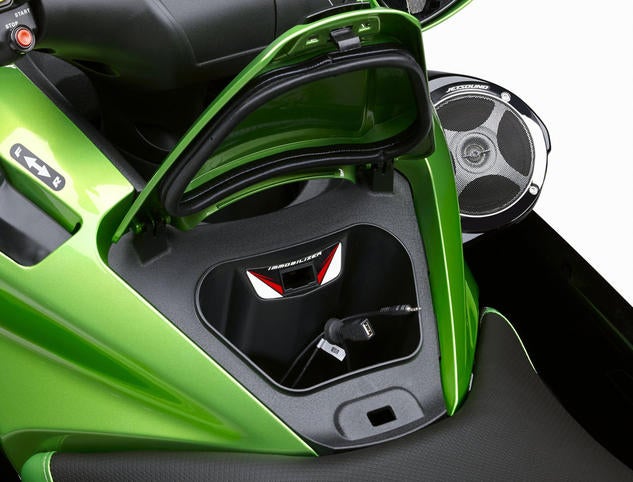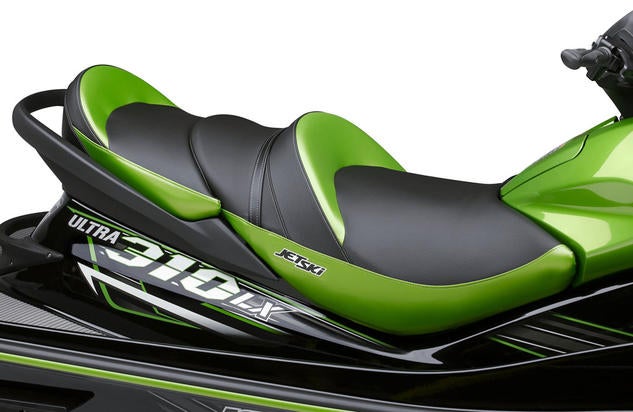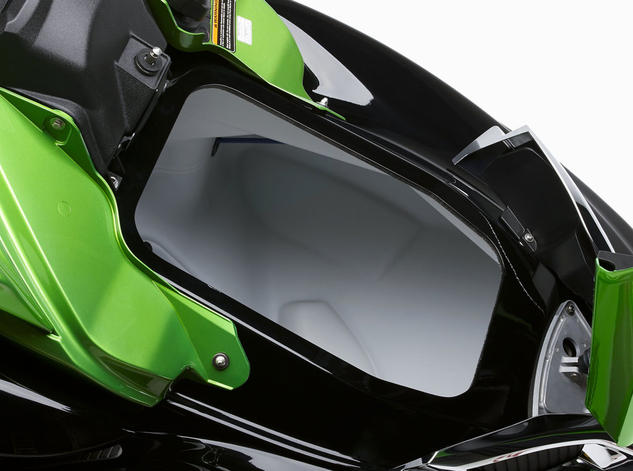2014 Kawasaki Jet Ski Ultra 310LX Review
It might get loud
Kawasaki has clearly upped the ante in 2014. Obvious is the addition of 10 horses to the Ultra 310LX’s name. But so, too, is a pair of round grills suddenly protruding below the mirrors. Some new type of vents for all that power…or just a fancy storage compartment lid? Nope, those are speakers, part of the new “Jetsounds” music system.
Yup, for 2014 the LX has got tunes. Let’s get this review cranking!
Music To Your Ears
The arrival of Jetsounds marks the first time an OEM has attempted to include an integrated sound system into a production craft. The system features dual, 60-watt speakers, a 40-watt amplifier, and a head unit controller. The amp is hidden below the handlebar pad, the speakers nicely integrated into the console below the mirrors, and the head unit front and center between the handlebars. The system is compatible with most audio players that feature a 3.5 mm stereo pin jack output, like the iPod or iPhone, as well as USB memory sticks. The former are housed within a waterproof dry bag inside the glove box; the latter a screw-top, waterproof aluminum cylinder case.
 You can see one of the Jetsounds speakers on the right, which are powerful enough to hear at nearly any speed.
You can see one of the Jetsounds speakers on the right, which are powerful enough to hear at nearly any speed.So how does it work, out on the water with the wind blowing and the water splashing? Surprisingly well. I found I could clearly hear the music at all but the highest speeds, and could easily control volume or choose sound tracks (only available if using the USB memory stick) via the Jenson-made head unit. Serious wave pounding also didn’t seem to produce a skip. Clearly, Kawasaki and ASA, the maker of Jensen audio systems, did their homework.
COMPARISON: Read our review of the 2013 Sea-Doo GTX Limited iS 260
I worried that the music would be a distraction, or prove annoying to other boats. But lo and behold, it didn’t. For the most part, I used music the same as I would in my car or boat, enjoying it responsibly, not getting distracted, and turning it down when I felt it would annoy the neighbors. So, too, did most of my fellow riders, both during Kawasaki’s press event and a later group shootout. Almost all my fellow riders also found themselves pleasantly surprised by the ability to listen to music while underway. I’ll continue to caution riders to stay alert and not overdo the volume, but I think it’s safe to say Jetsounds is a hit.
Sounds Of Power
So now, let’s hear the rest of the tracks.
The significant change is to the engine. Kawasaki didn’t go searching for those 10 extra horses, but they quickly found them when addressing several existing issues. Changes include a new, heat-resistant plastic intake manifold that added a boost to both low and midrange power, cast pistons with a new groove pattern to better retain oil and improve durability, a new fuel pump that offers increased flow for improved power and fuel efficiency, thicker water jackets for better cooling, one additional oil jet per piston for more cooling, a baffled oil pan to prevent oil slosh during acceleration or hard cornering, and — whew! — larger oil return holes in the crankscase to promote the easier return of oil to the pan. A second waterbox also lowers sound levels, and helps keep the boat more stable during low-speed maneuvering.
 Kawasaki made a host of changes to the Ultra 310LX for 2014, which resulted in an extra 10 horsepower.
Kawasaki made a host of changes to the Ultra 310LX for 2014, which resulted in an extra 10 horsepower.The pump also gets attention. The impeller is a revised design, with three blades and a longer nose to help instantaneous acceleration, as well as reduce rattles and noise.
These enhancements only make the existing engine – a 1,498cc inline four cylinder – that much better. Kawasaki switched to an Eaton Twin Vortices supercharger not long ago. Coupled with a liquid-cooled intercooler, it gives the 310 brutal acceleration out of the hole. That power continues to come on strong throughout the powerband, before peaking around 66.5 mph on my test boat. The funny thing is, it felt a lot faster than my GPS indicated.
COMPARISON: Read our review of the 2014 Yamaha FX SVHO
As to the Ultra’s hull, it’s the familiar 22.5-degree deadrise we’ve come to love. Ultras are offshore champs for good reason. They track straight and true, battling through even the biggest waves with authority. Pin the throttle, trim the bow up via the electric trim control, and you can almost skip across the wave tops. Find some calm water, trim that bow down, and you’ll be thrilled with the craft’s aggressive, hard-cornering response. Go ahead, take it through a buoy course. It will respond like a much smaller craft.
 If you trim down the bow in calm water the Ultra 310LX handles like a much smaller craft.
If you trim down the bow in calm water the Ultra 310LX handles like a much smaller craft.Luxury Extras
The 310LX may be Kawasaki’s ultimate touring craft, but amenities don’t go overboard. The saddle is touring-ready, with comfortable bolsters to give support to the lower back, and a tiered profile that positions passengers for a better view forward. For 2014, it’s also covered in a unique heat-resistant material that isn’t painful to sit on during a hot summer day. Storage and fuel capacity continue to be ready for the long haul. Storage tops out at 56 gallons, most of which is found in the cavernous front compartment, while fuel capacity tops the class at 20 gallons.
 Also new for 2014 is a heat-resistant material on the seat, which means the seat won’t burn you after it has been sitting in the sun all day.
Also new for 2014 is a heat-resistant material on the seat, which means the seat won’t burn you after it has been sitting in the sun all day.Electronic throttle makes possible cruise control and a no-wake mode, both easily activated via buttons adjacent to the throttle. A fuel economy mode also lets you tame the engine’s response to get the most out of the fuel aboard. Speed can be truly governed via a second activation key. You can also add your own handheld GPS to the handlebar pad. Just pop out the plug next to the Jetsounds control, fit your device using the appropriate bracket, and you’re ready to navigate.
COMPARISON: Read our review of the 2014 Kawasaki Jet Ski Ultra 310R
Not all the 310LX’s music is sweet. Price is one hurdle. At $17,999, this is now the most expensive craft on the market by a full $1,000. I also continue to caution riders about the aggressiveness of Kawasaki’s off-throttle steering response. Designed to provide thrust when an inexperienced rider releases the throttle but attempts a collision-avoidance turn, it comes on stronger than expected. That’s not a problem unless you’re cruising up on some friends to talk, or coming into shore a little hot. Keep a safe distance and you’ll be fine. Get a little careless and you might be in for some nervous moments.
 With 56 gallons of storage space, you can take plenty of supplies along for an all-day ride.
With 56 gallons of storage space, you can take plenty of supplies along for an all-day ride.In the overall scheme of things, however, the money and OTS quirk are probably minimal given this craft’s target audience. They’re too busy happily cruising along in comfort, or rocketing across the water at lightning speed…listening to their own personal soundtrack to worry about such things.
| 2014 Kawasaki Jet Ski Ultra 310LX Specs | |
| Length | 132.7 inches |
| Beam | 47.0 inches |
| Curb Weight | 1,073.8 lbs |
| Engine | Four-cylinder DOHC EFI; Supercharged/Intercooled |
| Displacement | 1,498 cc |
| Bore and Stroke | 83mm x 69.2mm |
| Compression Ratio | 8.2:1 |
| Rated Horsepower | 310 |
| Fuel Capacity | 20.6 gal. |
| Combined Stowage Capacity | 56 gal. |
| Colors | Ebony/Candy Lime Green |
| Price | $17,999 |
Get PersonalWatercraft.com in your Inbox!
Like PersonalWatercraft.com on Facebook
Comments
Most Popular

Remembering the Sea-Doo XP

2025 Yamaha JetBlaster PRO 2-Up Review

2024 Yamaha GP HO Review

2008 Kawasaki Jet Ski Ultra 250X Review

2024 Kawasaki Jet Ski STX 160X Review











 Your Privacy Choices
Your Privacy Choices